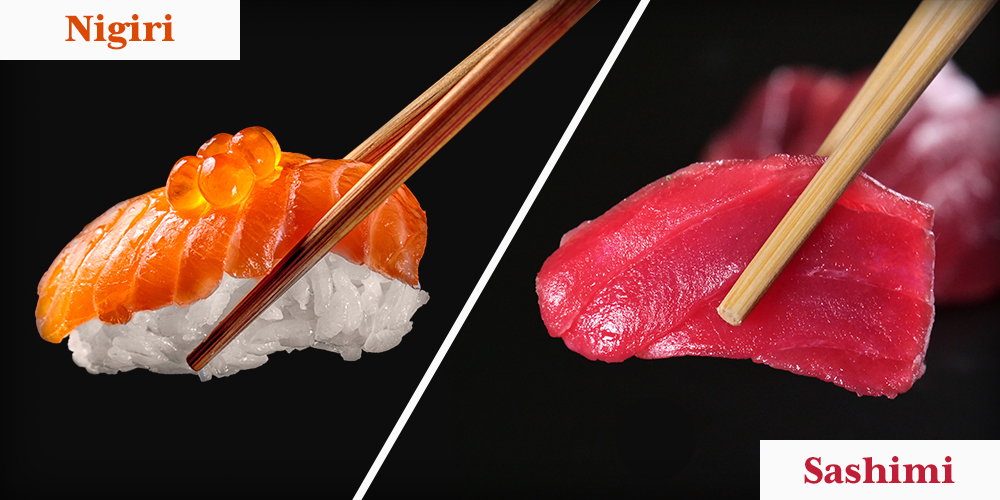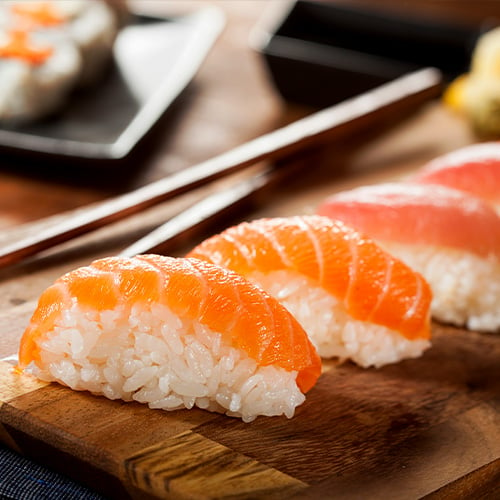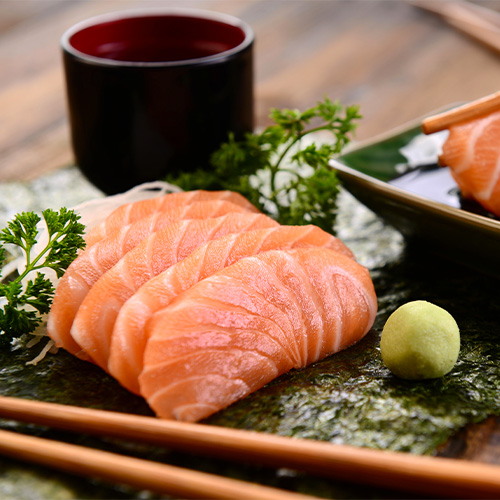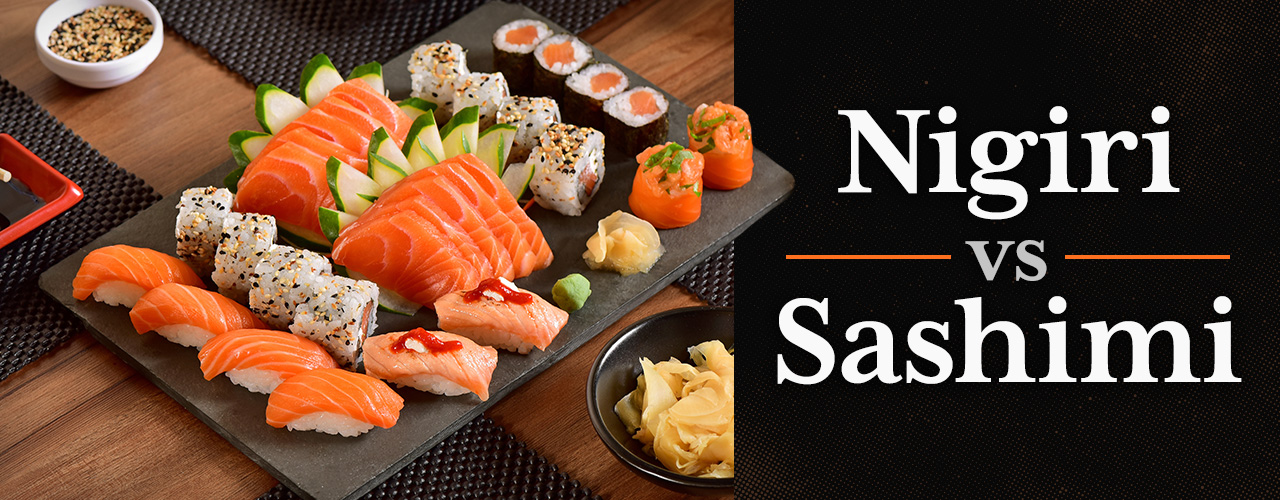When it comes to Japanese cuisine, sushi is often the first thing that comes to mind. Within the world of sushi, various types offer unique flavors and experiences. Two popular options are nigiri and sashimi. They usually appear together on sushi menus, but what are the differences? While both involve raw fish, they differ in how they are served and eaten.
Difference Between Nigiri and Sashimi

Shown here: Nigiri compared to sashimi. Nigiri features a slice of raw fish on top of a hand-pressed mound of vinegared rice, while sashimi is a slice of raw fish.
While both nigiri and sashimi feature raw fish, the key difference lies in the presentation. Nigiri is thinly sliced raw fish or meat laid over a bed of vinegared rice, whereas sashimi is thinly sliced raw fish or meat without any rice. Sashimi is all about showcasing the raw fish in its purest form, while nigiri elevates the experience by adding the complementary element of vinegared rice. It's worth noting that nigiri is a type of sushi, while sashimi is not. Sushi refers to any dish made with vinegared rice, while sashimi focuses solely on raw fish.
What Is Nigiri?

Nigiri is a type of sushi made up of an oval-shaped, hand-pressed mound of vinegared rice topped with a thin slice of raw fish or meat. Popular raw fish toppings include tuna, salmon, yellowtail, or mackerel. These particular fish varieties are known for their firm texture and rich fat content, resulting in a melt-in-your-mouth experience. It is common to have some cooked seafood options, such as shrimp, eel, or octopus nigiri. Typically, nigiri has a dollop of wasabi between the rice and meat to keep the topping in place.
Nigiri vs Sushi
Sushi is a Japanese cold dish with seasoned rice and fish or seafood, often raw. Sushi can be served in many ways, such as layering a sheet of seaweed with vinegared rice and fillings and rolling it into bite-sized pieces or simply placing the raw fish on a bed of rice. Nigiri is a sushi type that combines raw fish or meat with a bite-sized mound of vinegared rice.
How to Eat Nigiri
Since nigiri is a one-bite dish, it is socially acceptable to eat it with your hands. However, you can also use chopsticks (or a fork) to eat it. Nigiri is often served with soy sauce and pickled ginger on the side to enhance the flavors. When dipping nigiri into soy sauce, you should lightly dip the fish side into the sauce. Since the rice is already seasoned, it is not customary to dip the nigiri into the sauce rice side down.
What Is Sashimi?

Sashimi, which translates to “pierced body”, is a traditional Japanese dish of thinly sliced raw meat, typically fish and seafood, but it could be other types of meat. There is no rice used in the dish to enhance its taste; instead, the raw fish stands on its own and is enjoyed in its purest form. Because there is no rice, sashimi is not a type of sushi. However, it is often still found on many sushi menus. Sashimi and nigiri utilize the same variety of fish and meat, but sashimi is exclusively served raw. Due to its delicate and fresh flavor, sashimi is traditionally served as the first course in Japanese dining to prevent more complex dishes from overshadowing its taste.
Sashimi is often served on a platter or dish and comes with two to three pieces per order. It is served with a garnish of shiso (an aromatic Japanese herb) and shredded daikon radish alongside soy sauce for dipping and condiments such as wasabi and ginger. Compared to nigiri and other sushi, sashimi tends to be pricier because you are getting a more generous portion of protein.
How to Eat Sashimi
To properly eat sashimi, take one piece with your chopsticks, add a small dollop of wasabi on top of the fish, and fold it in half. Lightly dip the folded sashimi into your soy sauce and eat. Be careful not to use too much soy sauce with sashimi, as its richness easily overwhelms the delicate flavors of the raw fish. When enjoying a sashimi platter with various fish options, it is best to start with the lightest fish and progress towards the darkest to ensure you experience the flavors gradually intensifying from mild to more robust.
The main difference between nigiri and sashimi lies in their presentation and the inclusion of vinegared rice. While sashimi offers a pure and unadulterated taste of raw fish, nigiri combines the flavors of fish and vinegared rice for a more well-rounded sushi experience. So, whether you prefer the simplicity of sashimi or the harmonious blend of flavors in nigiri, both options offer a delightful journey into the world of Japanese cuisine.
Related Resources

Types of Asian Noodles
You can broadly categorize Asian noodles into three main types: wheat, rice, and glass noodles. However, there is a surplus of subcategories with distinct preparation methods, ingredients, shapes, and sizes. Reducing this dynamic cuisine to three unnuanced categories won’t help you navigate the Asian noodle aisle. Our guide to the ten most popular Asian noodles breaks down flavor, texture, and uses so you can find the soft, springy, or slippery Asian noodle that satisfies your needs. Shop All Asian Noodles Chef’s Guide to Asian Noodle Styles Our test kitchen chef guides you through the different types of Asian noodles, how to prepare them, and their best applications in foodservice environments. <iframe itemprop="embedURL" width="560" height="315" src="https://www.youtube.com/embed/F7bh7qteNGY?si=Q_laA0VKvuQ7NENN" frameborder="0" allowfullscreen></iframe> Types of Noodles with Pictures Browse our list of the top ten types of noodles with pictures so you can identify them when you shop. While China has more indigenous noodles than any other country, noodles are a staple food throughout Asia. From Thailand and Singapore to Korea and Japan, we explore different types of Asian noodles from various global cuisines. 1. Ramen Noodles Ramen noodles were made famous by ramen soup, a brothy umami-rich dish loaded with proteins, vegetables, and spices. Ramen noodles are composed of wheat flour, salt, water, and kansui. A type of mineral water, kansui contains sodium carbonate, potassium carbonate, and may contain phosphoric acid. Kansui imbues ramen noodles with their signature yellow hue and distinguishes them from other types of Japanese noodles. It also stiffens the noodles, inhibiting moisture absorption, and preventing them from becoming soggy in soup recipes. Texture plays a huge role in the enjoyment of ramen. Ramen’s consistency will vary by its shape and how long you boil it. Each boiling level has a specific name: bari-yawa (extra soft), yawa (soft), futsuu (medium), kata-men (firm), bari-kata (extra firm), and harigane (extra-extra firm). The firmer the noodles, the chewier their texture. Ramen Noodle Ingredients - Wheat Flour, Salt, Water, and Kansui Ramen Noodle Flavor - Ramen noodles have a salty, mild flavor that lends to any broth. Ramen Noodle Texture - Ramen noodles are firm without being crunchy. Ramen Noodle Shape - Ramen noodles can be thick, thin, flat, straight, or curly depending on their application. Types of Ramen Soup - Categorized by its base flavor, there are four types of ramen noodle soup: shio (salt-based ramen), shoyu (soy sauce-based ramen), miso (soybean paste-flavored ramen), and tonkotsu (pork bone broth ramen). 2. Udon Noodles Udon is a Japanese wheat-based noodle with a dense, chewy texture and little flavor. There are regional varieties that range in thickness, smoothness, and width. Udon has a signature white color no matter its regional rendition. You can purchase fresh or dried udon noodles to suit your recipe and storage needs. Dried udon noodles typically resemble fettuccine in shape and size. Fresh udon noodles often have rounder, plumper shapes. However, niche regions cut their udon into unique shapes. For example, in Aomori and Iwate Prefecture, they cut udon noodles into a signature triangle shape before adding them to mugi kakke soup. In the Tochigi region, they fold udon noodles into an ear shape for mimi udon soup. Mimi udon is a staple of New Year celebrations in the Senba region. Commonly served in hot broth, udon is considered comfort food. Udon also acts as a base for Japanese curry, is served cold with dipping sauce, and is incorporated in noodle salads. Popular toppings for udon dishes are green onions, shredded seaweed, and Japanese chili flakes. Udon noodles are popular throughout Southeast Asia and are the signature ingredient in the famous Korean dish, jajangmyeon. Udon Noodle Ingredients - Wheat Flour, Water Udon Noodle Flavor - Udon has a neutral flavor and lends well to spice-laden Asian sauces and broths. Udon Noodle Texture - Udon noodles are chewy and soft. Udon Noodle Shape - Most udon noodles are thick and long. Fresh udon is typically round, and dried udon is flat. Types of Udon Noodles - Hoto, Sanuki Udon, Inaniwa Udon, Kishimen, Ise Udon Lo Mein vs Udon The biggest difference between lo mein and udon is that lo mein is made with egg noodles and udon is a wheat noodle. Most udon noodles are wider than lo mein egg noodles. The addition of eggs makes lo mein noodles chewier than udon, and they hold up better in pasta dishes. The plain wheat-based udon noodle absorbs broth and is perfect for soups. 3. Rice Noodles You can loosely categorize Asian rice noodles under the Cantonese word fun or fen. Most Asian rice noodles are made from simple recipes of rice flour and water. From 5 cm long and 5 mm wide silver needle noodles to inch-wide chow fun noodles, Asian rice noodles come in all shapes and sizes. Rice noodles are the staple of many famous dishes like Singapore noodles, pho, and pad Thai. The same basic recipe is used to make rice paper for Vietnamese summer rolls. How do you cook rice noodles? Rice noodles will cook much faster than wheat-based noodles, but the actual length of time and cooking method depend on whether the rice noodles are fresh or dry. It only takes a couple of minutes to cook fresh rice noodles in warm water. Boiling fresh rice noodles will decimate their delicate composition. You don’t have to cook dried rice noodles at all, simply rehydrate them before adding them to your recipe. Rice Noodle Ingredients - Rice Flour, Water Rice Noodle Flavor - Rice noodles have a neutral flavor and readily absorb sauces and broths. Rice Noodle Texture - Rice noodles have a springy, chewy, and slippery consistency. Rice Noodle Shape - The most popular rice noodle variety is flat and long. Types of Rice Noodles - Rice Sticks, Rice Vermicelli, Kway Teow, Silver needle, Chow Fun, Chang Fun, Lai Fun Rice Noodles vs Lo Mein Lo mein noodles are made of wheat flour, water, and egg. Rice noodles are made with rice flour and water. If you’re looking for a slippery noodle to absorb the flavor of your sauce or broth, then rice noodles are the right choice for you. If you want a chewy, creamy noodle that makes a great base for pasta dishes, then lo mein (or another Chinese egg noodle) is the right fit for your recipe. 4. Soba Noodles Soba noodles are Japanese noodles made with buckwheat flour and water (soba is the Japanese word for buckwheat). Many varieties use a percentage of whole wheat flour to make the noodles sturdier. Pure buckwheat soba is called ju-wari soba, and 80% buckwheat soba is known as hachi-wari soba. For authentic, high-quality soba noodles, check the label and make sure they have at least 70-80% buckwheat flour. Soba noodles are higher in protein and fiber than other types of Asian noodles. People use them in hot noodle dishes, cold noodle salads, and brothy noodle soups. Soba noodles are an easy and delicious way to accommodate gluten-free patrons, just make sure the noodles you’re using are 100% buckwheat (ju-wari soba). Soba Noodle Ingredients - Buckwheat Flour, Water, Whole-Wheat Flour (sometimes) Soba Noodle Flavor - Soba noodles carry a nutty, earthy flavor. Soba Noodle Texture - Soba noodles have a chewy, grainy mouthfeel. Soba Noodle Shape - Soba noodles are sold in multiple thicknesses. They can be round- or square-shaped. Types of Soba Noodles - Ju-Wari Soba, Hachi-Wari Soba, Green Tea Soba, Ume Plum Soba 5. Glass Noodles Also known as cellophane noodles or bean thread noodles, glass noodles are skinny, long noodles made from water and starch derived from beans and tubers. Noodle makers use mung bean starch, sweet potato starch, tapioca starch, pea starch, and potato starch to make glass noodles. They are a gluten-free alternative to wheat-based noodles and pasta. Check the label and confirm they weren’t exposed to gluten during manufacturing before purchasing glass noodles for your gluten-free menu. Glass noodles are not always transparent; their color varies by the starch used. The most common type of glass noodle comes from China and is made with mung bean starch. Glass noodles made from sweet potato starch dominate the Korean and Japanese noodle market. Tapioca noodles are extremely popular in Vietnam and are used to make the Central and Southern Vietnamese dish, crab tapioca noodle soup. Glass Noodle Ingredients - Water, Vegetable Starch (commonly mung bean, sweet potato, or tapioca) Glass Noodle Flavor - Most glass noodle varieties have a mild flavor with a slight sweetness. Glass Noodle Texture - Glass noodles have a gelatinous, slightly chewy consistency. Glass Noodle Shape - Most glass noodles are long and thin. Types of Glass Noodles - Mung bean starch glass noodles, Sweet potato starch glass noodles, Arrowroot starch glass noodles, Tapioca glass noodles 6. Chow Mein Noodles Mein is the Chinese word for noodles, and chow means fried, so chow mein simply means fried noodles. The noodles used in chow mein dishes are usually egg noodles browned in oil on both sides, earning them the nickname “twice-browned noodles". There are two main types of chow mein: steamed chow mein and crispy chow mein. To make steamed chow mein, chefs flash fry the egg noodles before tossing them with the rest of the ingredients and coating them in a light sauce. For crispy chow mein, chefs press the noodles flat while frying them. The chow mein dish you’ll find on most Chinese food menus was created by Chinese Americans. It evolved from an authentic dish known as ch’ao mien, aka “stir-fried noodles”. In American Chinese cuisine, chow mein is known as a specific dish made with egg noodles, meat, and vegetables bathed in a dark, thick, soy-based sauce. Chow Mein Noodle Ingredients - Chow mein noodles are typically egg noodles composed of egg, water, and wheat flour. Chow Mein Noodle Flavor - The sauce used for Americanized chow mein dishes masks the noodles’ mild flavor. Composed of soy sauce, oyster sauce, sesame oil, and cornstarch, chow mein sauce offers a mildly sweet, savory flavor profile. Chow Mein Noodle Texture - The texture of chow mein noodles ranges from stiff to crunchy depending on how they’re fried. Chow Mein Noodle Shape - The noodles used in chow mein can be round or flat. Types of Chow Mein Noodles - Choose fresh egg noodles for a softer chow mein dish and dried egg noodles for a crispy chow mein recipe. Chow Mein vs Lo Mein The Chinese word mein means noodles, so both chow mein and low mein are noodle dishes. Chow mein translates to “fried noodles” in English and lo mein translates to “stirred or tossed noodles”. Chefs soften chow mein noodles in hot water before adding them to a wok with oil and the other ingredients they’re stir-frying. For lo mein noodles, chefs cook the noodles before mixing them with meat, vegetables, and slathering them in a rich sauce. 7. Vermicelli Noodles The term vermicelli encompasses a broad category of thin Asian noodles. The noodle must have a diameter of less than 0.06 inches (1.5 mm) to be classified as vermicelli. The most popular type of Asian vermicelli noodle is rice vermicelli. Rice vermicelli noodles are known as bee hoon in Hokkien Chinese, mai fun in Cantonese Chinese, wunsen in Thai, kya zan in Burmese, and bun in Vietnamese. Since vermicelli designates size, not ingredients, you'll encounter different types of vermicelli noodles dominating regional and national sales landscapes. In Vietnam, vermicelli noodles are the same as angel hair pasta. In China, you’ll find wheat vermicelli (misua) and various mung bean vermicelli noodles. Thailand is famous for its mung bean vermicelli, pad woon sen. Vermicelli Noodle Ingredients - There are rice, wheat, mung bean, potato starch, and tapioca vermicelli varieties. Vermicelli Noodle Flavor - The flavor of vermicelli noodles varies by type. The most common, rice vermicelli, absorbs the flavor of sauces and broths. Vermicelli Noodle Shape - Vermicelli noodles are round, extremely thin (diameter of less than 0.06 inches aka 1.5 mm), and up to 18 inches long. Types of Vermicelli Noodles - Misua, Pad Woon Sen, Mai Fun, Bun, Kya Zan 8. Somen Noodles Somen noodles are wispy (less than 0.05 mm in diameter), pale, Japanese wheat noodles made from superfine wheat flour, salt, and water. After it’s hand-stretched into thin strips, somen noodle dough is coated in vegetable oil to prevent over-air-drying. Due to their thread-like consistency, you can cook somen noodles in under 3 minutes in boiling water; because the noodles contain salt, don’t salt the water before boiling them. Once cooked, rinse the somen in cold water to remove the oil. Summers in Japan are sweltering, and slurping cold somen noodles is a popular way to cool down. Cold somen noodles are dipped in umami-rich tsuyu sauce made by combining soy sauce, rice wine, sake, dried kelp, and dried bonito flakes. Many restaurants create an interactive serving experience known as nagashi somen. Invented after World War II, restaurants serve nagashi somen by dropping somen noodle clusters into a chute of running water. Patrons scoop the somen clusters out of the water with chopsticks as they float down, and then dunk them in a sauce. Somen noodles are enjoyed in hot soups and stir-fries during the colder months. Somen Noodle Ingredients - Wheat Flour, Salt, and Water Somen Noodle Flavor - Somen noodles have a very mild flavor and are best with a tangy sauce. Somen Noodle Texture - Somen noodles have a light and slippery texture. Somen Noodle Shape - Somen noodles are cylindrical with a diameter of less than 0.05 mm. Types of Somen Noodles - Miwa Somen, Shimabara Somen, Shima No Hikari Somen 9. Chinese Egg Noodles Chinese egg noodles, also known as egg noodles, are timeless Asian noodles composed of wheat flour, water, and eggs. You can find egg noodles shaped into both thick and thin strands. Chinese egg noodles are beloved for their springy, chewy consistency. They are the staple ingredient in classic Chinese meals like chow mein, wonton soup, and lo mein. Some retailers cut corners and use food coloring to tint their noodles instead of eggs, so check ingredient labels to confirm you’re getting authentic egg noodles. Chinese egg noodles are distinct from the German egg noodle pasta known as spaetzle. Irregularly shaped and short, spaetzle is usually made with semolina flour, milk, and eggs. Spaetzle has a consistency reminiscent of a dumpling. In contrast, classic Chinese egg noodles are long, thin, and uniform. They are either round or flat and provide a springy, chewy texture. You cannot use these two distinct ingredients interchangeably. Chinese Egg Noodle Ingredients - Wheat Flour, Water, and Egg Chinese Egg Noodle Flavor - Egg noodles offer a slightly creamy mouthfeel, but they carry little flavor. Chinese Egg Noodle Texture - Egg noodles have a springy, chewy consistency. Chinese Egg Noodle Shape - Popular Chinese egg noodles come in long strands that are either thin like spaghetti or flat like linguine. Types of Chinese Egg Noodles - Chow Mein Noo, Lo Mein, Thin Wonton Noodles, Wide Wonton Noodles 10. Kal-Guksoo Noodles Kal-Guksoo is a Korean noodle made from wheat flour, water, and eggs distinct from Chinese egg noodles due to their preparation method. Korean noodle makers roll kal-guksoo dough into a thin rectangle and then slice it into ribbons with a knife. Kal-guksoo translates to knife noodles in English, since they are cut rather than strung or spun. Some kal-guksoo varieties incorporate dried bean powder or mashed mung beans into their dough as thickening agents. Kal-guksoo is considered a summer seasonal food. It’s usually served in a large bowl with broth and other ingredients like shellfish and vegetables. The traditional broth for kal-guksoo is composed of shellfish, kelp, and dried anchovies. Chicken broth would be the second most popular choice. Chefs build a rich flavor by slowly simmering kal-guksoo broth. Kal-guksoo noodles are either boiled in the broth alongside popular Korean vegetables like zucchini, potatoes, and scallions or they’re added at the end. This mild soup is often served with kimchi for added flavor. Kal-guksoo Noodle Ingredients - Wheat Flour, Water, and Eggs Kal-guksoo Noodle Flavor - Kal-guksoo noodles have a mild and creamy flavor. Kal-guksoo Noodle Texture - Kal-guksoo noodles have a doughy, bouncy consistency. Kal-guksoo Noodle Shape - Kal-guksoo noodles have a long, flat shape. Types of Kal-guksoo Noodles - Mung Bean Kal-guksoo, Hobak Pumpkin Kal-guksoo, Perilla Seed Kal-guksoo, Millet Kal-guksoo Asian Noodles FAQs Now that you have a grasp of the most popular types of Asian noodles, you probably have additional questions about how they’re cooked and the nuances between them. From where to buy Asian noodles to how long they’ll last, we answer chefs' most frequently asked Asian noodle questions below. How Are Noodles Made? Today, most grand-scale noodle manufacturers use the roll and cut method to make their noodles. To perform the roll and cut method, noodle dough is salted, thoroughly kneaded, and rested. Once it reaches its desired consistency, the noodle dough is sent through a series of rollers and transformed into a long sheet. The final roller has a cutter attached to it, which the manufacturer can adjust to customize thickness. The noodle sheet is cut into two-meter-long strands. These 2-meter-long ribbons are moved to a drying room where they are left to naturally air dry. After a minimum of 30 hours have passed, the noodle ribbons are cut and packaged. While time-consuming, the labor of love provides rich flavor and aids digestion. How Long Do Fresh Noodles Last? Fresh noodles will last between three and four days in the fridge. You can purchase fresh-frozen noodles that will last several months in your freezer. How Long Do Dry Noodles Last? Dry noodles will taste best if you use them within six or seven months of purchasing them. Preserve their quality by storing them in a cool, arid area. Where to Buy Asian Noodles? In years past, you would have to visit an Asian market to buy Asian noodles in the US. As they’ve risen in popularity and charmed the American palate, many of the most popular Asian noodles are available on the international foods aisle at large grocery outlets. One of the most cost-effective ways to stock up on Asian noodles is to order them online from a restaurant retailer like WebstaurantStore. You’ll get easy access to a broad selection with the convenience of having them delivered straight to you. Pasta vs Noodles People often confuse pasta and noodles. Pasta, the signature dish of Italy, is made from durum semolina, a tetraploid species of wheat with a yellow endosperm and a coarser texture than common wheat. Pasta artisans extrude pasta dough into various shapes by forcing the dough through a shaped opening (not unlike what you did as a child with Play-Doh). In contrast, Asian noodle makers string, spin, or cut their noodles. Traditionally, Asian noodles are made with flour milled from common wheat, rice flour, or starch from a tuber or bean. Because traditional Asian noodles use softer flours and starches than pasta, most noodles employ salt as a binding agent, whereas Italian pasta typically forgoes salt. According to a Pew Research Center report, the Asian population is the fastest-growing racial group in America. Pair this demographic reality with food trends toward healthier eating and globally-inspired cuisine, and it’s no wonder that Asian-inspired dishes are dominating the food landscape. Greasy, Americanized Chinese food isn't the only Asian food option anymore. The modern consumer is looking for nourishing dishes, global fusion-style meals, and favors authentic Asian ingredients. Use our guide to the best Asian noodles to revamp your menu and meet the growing demand.

Types of Asian Sauces
Asian cuisines are known for their bold and diverse flavors, and one of the key elements that contribute to this is the wide variety of sauces used in Asian cooking. From tangy and spicy to sweet and savory, Asian sauces add depth and complexity to dishes. Whether you're looking to enhance the flavors of your Asian noodles, stir-fries, marinades, or dipping sauces, understanding the different types of Asian sauces can help you create authentic and delicious dishes that will impress your customers. Shop All Asian Sauces Click below to skip to the Asian sauce that most interests you: Soy Sauce Hoisin Sauce Teriyaki Sauce Oyster Sauce Sweet and Sour Sauce Fish Sauce Sweet Chili Sauce Gochujang Sauce Ponzu Sauce Duck Sauce Asian Sauces List We explore some of the most popular Asian sauces and discuss their unique characteristics and culinary uses: 1. Soy Sauce Soy sauce is a staple ingredient in Asian cuisine, known for its rich umami flavor. Made from fermented soybeans, roasted grains, water, and salt, soy sauce adds depth to a variety of dishes. Whether you’re using soy sauce as a marinade or providing soy sauce packets for your customers to use with their to-go orders, this foundational Asian sauce is perfect for adding bold flavors to your signature dishes. What Does Soy Sauce Taste Like? Salty, umami, and slightly sweet How to Use Soy Sauce: As a marinade, dipping sauce, or seasoning for noodles and stir-fry Types of Soy Sauce: Light soy sauce (saltier and lighter in color) and dark soy sauce (thicker consistency and slightly sweet) Substitutes for Soy Sauce: Tamari, coconut aminos, fish sauce, liquid aminos, or Worcestershire sauce 2. Hoisin Sauce Made from a combination of soybeans, garlic, vinegar, and various spices, hoisin sauce is commonly used in Chinese, Vietnamese, and Thai cuisine. Its thick and sticky consistency makes it ideal for everything from glazing meats to offering it as a dipping sauce for spring rolls and dumplings. Hoisin sauce has a sweet and savory flavor that adds a level of complexity to your dishes. What Does Hoisin Sauce Taste Like? Sweet and salty How to Use Hoisin Sauce: As a dipping sauce for appetizers like spring rolls and dumplings, as a marinade for meat and vegetables, or as a glaze for Peking duck Substitutes for Hoisin Sauce: Oyster sauce, barbecue sauce, fish sauce, miso paste, or a combination of soy sauce, peanut butter, and honey Hoisin Sauce vs Soy Sauce While hoisin sauce adds a rich and savory flavor to dishes, soy sauce brings a salty and umami taste. Hoisin sauce is a thick, dark sauce that is slightly sweet and tangy, with a hint of garlic and five-spice flavor. It is commonly used in Chinese cuisine, particularly in dishes like Peking duck and moo shu pork. Contrastingly, soy sauce is a thin, salty sauce made from fermented soybeans, wheat, and salt. It is a staple in many Asian cuisines and is used as a seasoning or marinade for various dishes. 3. Teriyaki Sauce Teriyaki sauce is an Asian sauce that originated in Japan. It is made from a combination of soy sauce, sugar, and mirin, a sweet rice wine. Teriyaki sauce is known for its sweet and savory flavor, and it is commonly used as a marinade or glaze for meats, such as chicken, beef, or salmon. It can also be used as a dipping sauce or as a flavoring for stir-fried vegetables. The sauce is typically thick and glossy, coating the food with a rich and caramelized glaze. What Does Teriyaki Sauce Taste Like? Sweet and tangy with a distinct umami taste How to Use Teriyaki Sauce: As a glaze and marinade for meats, as a dipping sauce for appetizers like spring rolls or potstickers, or as a seasoning for stir-fry dishes Substitutes for Teriyaki Sauce: Oyster sauce, a combination of soy sauce, honey, and ginger, or a combination of Worcestershire sauce and sugar Teriyaki Sauce vs Soy Sauce While both sauces add depth and umami to dishes, teriyaki sauce is sweeter and more suitable for glazing, while soy sauce provides a bold and salty flavor to enhance the overall taste of a dish. Teriyaki sauce is a sweet and savory sauce made from soy sauce, sugar, and mirin. On the other hand, soy sauce is a dark, salty sauce made from fermented soybeans, wheat, and salt. 4. Oyster Sauce Oyster sauce is a popular condiment in Asian cuisine that is made from oysters (reduced and caramelized), soy sauce, sugar, and seasonings. It has a rich and savory flavor that adds depth to stir-fries, marinades, and dipping sauces. Oyster sauce is known for its thick consistency and dark brown color, making it a versatile ingredient for adding umami to dishes. It is commonly used in Chinese, Thai, and Vietnamese cooking, and its unique flavor profile complements a wide range of ingredients, from vegetables to meats. What Does Oyster Sauce Taste Like? Rich, briny, and sweet with a fishy umami How to Use Oyster Sauce: As a marinade, to season stir-fry, in dumpling fillings, and in soup Types of Oyster Sauce: Chinese oyster sauce, Thai oyster sauce (less salty with a stronger oyster flavor) Substitutes for Oyster Sauce: Hoisin sauce, teriyaki sauce, fish sauce, and soy sauce with sugar Hoisin Sauce vs Oyster Sauce The difference between hoisin sauce and oyster sauce is that hoisin sauce is sweeter and thicker, while oyster sauce has a more savory and briny taste. Hoisin sauce is made from soybeans, garlic, vinegar, and spices. It is commonly used as a dipping sauce for spring rolls, dumplings, and Peking duck. Oyster sauce is made from oyster extract, soy sauce, and other seasonings. It has a rich, umami flavor and is often used to enhance stir-fries, vegetables, and seafood dishes. 5. Sweet and Sour Sauce Sweet and sour sauce is an Asian condiment that combines the flavors of sweetness and tanginess. It is typically made with a combination of sugar, vinegar, soy sauce, pineapple juice, and ketchup. The sauce is typically thickened with cornstarch, giving it a smooth and glossy texture. The sauce is known for its vibrant red color and being served with sweet and sour chicken. Its unique combination of sweet and sour flavors makes it an excellent choice for dipping sauces, marinades, and glazes. What Does Sweet and Sour Sauce Taste Like? Sweet and tangy with a hint of umami How to Use Sweet and Sour Sauce: As a dipping sauce for appetizers like spring rolls and sweet and sour chicken, as a glaze for meats and vegetables, or as a seasoning for stir-fried dishes Substitutes for Sweet and Sour Sauce: Sweet chili sauce, teriyaki sauce with ketchup and vinegar, or a combination of pineapple juice, soy sauce, and brown sugar Back to Top 6. Fish Sauce Made from fermented fish and salt, fish sauce is commonly used in Thai, Vietnamese, and Filipino dishes to add a savory flavor. Fish sauce has a distinct aroma and a strong, salty taste. Despite its strong smell, fish sauce mellows out when cooked and enhances the flavors of other ingredients. It is often used as a base for dipping sauces, marinades, and dressings. What Does Fish Sauce Taste Like? Salty and fishy with a hint of sweetness How to Use Fish Sauce: As a seasoning in stir-fries, as a marinade for meats, as a dipping sauces for appetizers, and in soups Types of Fish Sauce: Vietnamese fish sauce (nuoc mam), Thai fish sauce (nam pla) Substitutes for Fish Sauce: Oyster sauce, soy sauce with minced anchovy, seaweed, mushroom and soy sauce broth, or miso paste Fish Sauce vs Oyster Sauce While fish sauce adds a savory depth to dishes, oyster sauce adds a touch of sweetness and a glossy finish. Fish sauce is made from fermented fish and has a salty, savory taste. It is commonly used as a flavor enhancer in dishes like stir-fries, soups, and marinades. Oyster sauce is made from oysters and has a rich, sweet flavor. It is often used as a finishing sauce or a glaze for meats and vegetables. 7. Sweet Chili Sauce Sweet chili sauce adds a delightful balance of sweetness and heat to dishes. Made from a blend of red chili peppers, sugar, vinegar, and garlic, this sauce is often used as a dipping sauce for appetizers like spring rolls or chicken wings, or as a glaze for grilled meats and seafood. Sweet chili sauce is also a great addition to stir-fries, noodle dishes like ramen and pho, and marinades, adding a touch of spiciness and sweetness to elevate the taste of the dish. What Does Sweet Chili Sauce Taste Like? Sweet and tangy with mild spiciness How to Use Sweet Chili Sauce: As a dipping sauce for spring rolls and chicken wings, as a glaze for grilled meats and seafood, or as a seasoning for stir-fries Substitutes for Sweet Chili Sauce: Hot honey, hoisin sauce and hot sauce, plum sauce and hot sauce, or a combination of hoisin sauce, vinegar, and red pepper flakes Sweet Chili Sauce vs Sweet and Sour While sweet chili sauce and sweet and sour sauce may appear similar in color, both a vibrant orange, they have their distinct differences. Sweet chili sauce is made from a blend of red chili peppers, sugar, vinegar, garlic, and spices. It has a sweet and spicy taste, making it a versatile condiment for dipping, marinating, or glazing. Sweet and sour sauce combines the flavors of sweet and tangy with a hint of sourness. It is typically made from a mixture of sugar, vinegar, soy sauce, fruit juice, and ketchup. Sweet and sour sauce is commonly used as a dipping sauce for appetizers or as a sauce for stir-fried dishes. Chili Sauce vs Sweet Chili Sauce Chili sauce and sweet chili sauce have similar base ingredients but their own distinct flavor profiles. Chili sauce, often referred to as sriracha, is known for its fiery heat and tangy taste. Made from chili peppers, vinegar, and garlic, it adds a bold kick to dishes. Sweet chili sauce offers a milder alternative with a delightful balance of sweetness and spiciness. It typically contains chili peppers, sugar, and vinegar, creating a versatile sauce that can be used as a dip or glaze. 8. Gochujang Sauce Gochujang is a popular Korean sauce that adds a unique and spicy kick to dishes. Made from fermented soybeans, red chili powder, and glutinous rice, gochujang sauce is known for its bold flavors and rich taste. It is commonly used as a marinade for meat, a base for stews and soups, or as a dipping sauce. Gochujang can also be used to add depth to stir-fries, noodles, and even salad dressings. What Does Gochujang Sauce Taste Like? Sweet, smoky, and spicy How to Use Gochujang Sauce: As a marinade for meats, as a dipping sauce for vegetables, or as a base for stews and soups; used for dishes like bibimbap, tteok-bokki, and bulgogi Substitutes for Gochujang Sauce: Sriracha, chili garlic sauce, hoisin sauce, or harissa paste Gochujang vs Sriracha Gochujang and sriracha are two Asian sauces that can add a little heat to your dish. Gochujang, a Korean sauce, is made from fermented soybeans, chili peppers, and glutinous rice. It has a deep, complex flavor with a balance of sweetness and spiciness. Gochujang is commonly used as a base for stews, marinades, and dipping sauces. Sriracha, a Thai chili sauce, is made from chili peppers, vinegar, garlic, sugar, and salt. It has a tangy, spicy flavor with a hint of sweetness. Sriracha is often used as a condiment for adding heat to various dishes such as noodles, stir-fries, and sandwiches. 9. Ponzu Sauce Ponzu sauce is a citrus-based sauce commonly used in Japanese cuisine. It is made by combining soy sauce, rice vinegar, and citrus juice, typically from yuzu (an Asian citrus fruit) or lemon. Ponzu sauce has a tangy and slightly sweet flavor, which makes it a versatile condiment for various dishes. It is often used as a dipping sauce for tempura, sushi, and sashimi, or as a marinade for grilled meats and seafood. Additionally, Ponzu sauce can be used to enhance the flavors of salads, noodles, and stir-fried vegetables. What Does Ponzu Sauce Taste Like? Tangy citrus with some sweetness How to Use Ponzu Sauce: As a dipping sauce for sushi and sashimi, as a dressing for salad, or as a marinade for grilled meats and seafood Types of Ponzu Sauce: Yellow ponzu (regular ponzu sauce), ponzu soy sauce, dashi ponzu soy sauce, yuzu ponzu sauce, and sesame ponzu sauce Substitutes for Ponzu Sauce: Soy sauce and lemon juice, lime juice and Worcestershire sauce, or a combination of rice vinegar, soy sauce, and a small amount of sugar Ponzu vs Soy Sauce Ponzu is a tangy and citrusy sauce made from rice vinegar and citrus juice, typically from yuzu or lemon, that often includes soy sauce. It is commonly used as a dipping sauce for sushi, sashimi, and tempura, or as a dressing on salad. Soy sauce is a savory and salty sauce made from fermented soybeans, wheat, water, and salt. It is a staple in Asian cuisine and is used as a seasoning or condiment for various dishes, such as stir-fries, fried rice, and noodle dishes. While both sauces add depth and flavor to dishes, ponzu offers a refreshing and acidic taste, while soy sauce provides a rich salty flavor. 10. Duck Sauce Duck sauce is a sweet and tangy sauce that is made from a combination of apricot preserves, plums, vinegar, sugar, and spices. Despite its name, duck sauce does not actually contain any duck. It is often served as a dipping sauce for dishes such as egg rolls, dumplings, and roasted duck. With its unique flavor profile, duck sauce adds a delightful burst of sweetness to any dish it accompanies. What Does Duck Sauce Taste Like? Sweet and tart How to Use Duck Sauce: As a dipping sauce for appetizers, dim sum, and crispy duck, or a seasoning for fried rice and noodles Substitutes for Duck Sauce: Plum sauce, sweet and sour sauce, sweet chili sauce, or hoisin sauce Why Is It Called Duck Sauce? Duck sauce was given its name because it is often served with duck entrees, particularly Peking duck. The sauce itself does not contain duck, but it is a sweet and tangy blend made from apricots, plums, sugar, vinegar, and spices. It is often served as a dipping sauce fried foods and dumplings, adding a burst of flavor to these dishes. Duck Sauce vs Sweet and Sour Despite their similar orange color, duck sauce and sweet and sour sauce are two different Asian sauces. Duck sauce is a sweet and tangy condiment made from plums, apricots, sugar, and vinegar. It is commonly used as a dipping sauce for egg rolls, dumplings, and roasted duck. Sweet and sour sauce is a combination of sweet and tangy flavors that typically includes sugar, vinegar, pineapple juice, ketchup, and soy sauce. It is often used as a glaze for fried or battered meats and vegetables. While both sauces provide a sweet and tangy taste, duck sauce has a fruitier flavor profile due to the use of plums and apricots, while sweet and sour sauce has a more savory taste with the addition of ketchup and soy sauce. Back to Top From the rich and savory soy sauce to the sweet and tangy duck sauce, Asian sauces can enhance the taste of dishes and add a unique twist to your menu. Whether it's stir-fries, marinades, or dipping sauces, the versatility of these Asian sauces makes them a must-have for any restaurant or foodservice establishment. With their ability to elevate flavors and create authentic Asian cuisine, your customers are sure to come back for more.

What Is a Bento Box?
A bento box is a Japanese single-portion boxed meal consisting of several different food types. Bento boxes have multiple compartments, allowing the preparer to separate the various foods into neat and aesthetically-pleasing portions. Bento boxes initially gained popularity due to their convenience and ease of preparation, and today they are a well-known food trend due to their variety of flavors, unique designs, and portability. Below, we’ll cover everything you need to know about bento boxes, including how to make one and how you can utilize popular bento box ideas in your establishment. Shop All Bento Boxes Use these links to learn more about bento boxes: What’s in a Bento Box? How to Make a Bento Box Bento Box Origin Bento Box Ideas What's in a Bento Box? Although there are different types and styles of bento boxes, most contain a starch, a protein, and an assortment of fruits and vegetables. One of the reasons bento boxes are so popular is due to the balanced nutritional profile they offer. With bento, the customer has access to several food groups, creating a well-balanced meal. Due to the portability of bento boxes, customers can take their healthy lunch or dinner options on the go. How to Make a Bento Box Some of the main attractions of bento boxes are their simplicity and ease of assembly. Although you can get creative with your bento box designs, standard bento boxes have three main components of a starch, a protein, and vegetables. You can mix and match different options within each food group, creating wildly different flavor combinations with the same base idea. Here are some of the most common food items to consider when making a bento box: Starch - The most common starch found in bento boxes is rice, but there are other options to consider. Asian noodles are a common alternative, or you can get creative and include onigiri, Japanese rice balls made from cooked sushi rice. Protein - The proteins in your bento box are where you can get the most creative due to the variety of foods you can include. Some potential proteins you can add to your bento box include chicken, beef, pork, seafood, and eggs. Fruits and Vegetables - Sliced fruits and vegetables are often included in bento boxes as a side to the main course. Some examples of bento box vegetables include broccoli, carrots, peas, and edamame while you’ll find fruits such as grapes, apple slices, and cherry tomatoes. Bento Box Origin Bento boxes have been a part of Japanese culture for a long time, dating back almost a thousand years. The idea gained newfound prominence in the early 1900s as parents started using them as lunch options for schoolchildren. Around the same time, train stations became more common in Japan, turning bento into a popular travel food. The emergence of convenience stores and similar quick-service locations in the 1980s was also key to the recent growth in the popularity of bento boxes, launching them into the global trend they are today. Bento Box Ideas Bento boxes are a unique way to package and present on-the-go lunch options, allowing you to get creative with your ideas. Over time, many different variations of bento boxes have been created. Some types of bento boxes may have unique ingredients, while others may be styled into specific designs. Here are some of the most common bento box ideas that you can utilize in your establishment: 1. Ekiben Ekiben or “train station bento” is one of the most common forms of bento found around the world. This type of bento tends to be more extravagant than other types, often using high-end ingredients like salmon or crab. Although ekiben is “travel food”, traveling is often seen as a luxury in Japan, and ekiben is designed to be a luxurious food that showcases regional flavor and ingredients. For upscale restaurants, Ekiben bento is a fantastic way to explore Japanese cuisine while providing a great take-home option for customers. 2. Konbini Konbini is the abbreviated form of konbiniesu sutoru, the Japanese word for convenience store. In Japan, bento boxes are common in konbinis, with konbini bento being a common affordable lunch for many working-class individuals. Konbini bento is a basic bento box with the standard makeup of rice, fish, and vegetables. Although this type of bento may not be as intricate as other types, it’s simple to make and provides customers with a fantastic affordable lunch option. 3. Koraku The literal translation of Koraku is “picnic lunchbox”, an apt name for a type of bento designed to be shared outdoors among multiple people. Traditionally, these bento boxes are enjoyed in March and April and are closely related to the Japanese Cherry Blossom Festival. Koraku bento is much larger than other bento boxes, as they are meant to serve multiple people. These are great to offer during the spring and summer months, providing customers with their very own picnic in a box. 4. Kyaraben Kyaraben, also known as character bento, is a type of bento that consists of food cut and decorated to resemble characters from popular media. Kyaraben started as a way for parents to entice their children to try a variety of foods, presenting healthy meals in the form of cute character designs. Due to the global rise in the popularity of Japanese media such as manga and anime, kyaraben has become a popular form of bento around the world. Kyaraben is now much more than an attractive way to present healthy foods to children, as many adults love both the aesthetics and taste of kyaraben boxes. 5. Hinomaru Translating to “circle of the sun”, Hinomaru bento is designed to look like the Japanese flag. Hinomaru bento consists of steamed rice and a pickled plum called umeboshi in the center, a display of red and white colors just like the Japanese flag. This type of bento is one of the easiest to create, making it an easy addition to your establishment's offerings. 6. Aisai Aisai bento translates to “Bento made by loving wife”, and is typically made by a partner for their significant other or children. This type of bento is also made and given by young romantics to show their affection. Aisai bento boxes consist of a well-balanced flavor profile and contain strong motifs of love and romance. As a result, this type of bento is perfect as an addition to your Valentine's Day menu. Bento boxes have been a staple in Japanese culture for years, but since it has become a global trend in recent times, it presents the perfect opportunity for restaurants and businesses. Creating a bento box is a straightforward process, but allows plenty of room for creativity and expression. A well-designed bento box filled with quality foods and ingredients can serve as the perfect take-out or delivery option for customers. The various types and styles of bento also allow you to experiment and create different bento boxes, expanding your delivery and take-out menu and keeping customers coming back to try new bento boxes.





